Khichan Bird Sanctuary is one of the more offbeat highlights of Rajasthan, and a wholly unexpected wildlife marvel in India’s Thar Desert.
Around 145 kilometres north-west of Jodhpur in Rajasthan – India’s ancient ‘Land of Kings’ – the village of Khichan emerges through a dusty haze.
At first glance, there’s nothing extraordinary about this small settlement in the parched, sparse landscape of the Thar Desert. It seems an unlikely place for a wildlife spectacle.
For one bird species though, the elegant Demoiselle crane, it’s a paradise worth migrating across a continent for.
This is where you’ll find the Khichan Bird Sanctuary, one of the most unexpected highlights of Rajasthan.
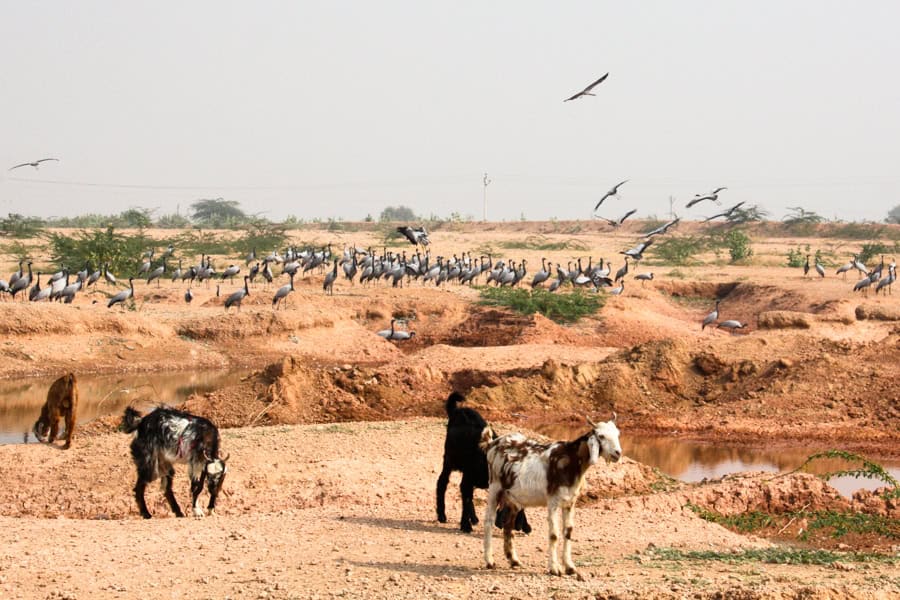
Our encounter with Khichan’s Demoiselle cranes, known locally as Kurja, came about during one of our own epic journeys in India, an unforgettable road trip tour of Rajasthan.
From the country’s capital of New Delhi, we crossed into Rajasthan and looped a path right around the vast state, exploring a vibrant palette of cities, villages, cultures and traditions, historic sights, wildlife and ever-changing landscapes.
In the days leading up to the cranes, we’d travelled from the entrancing Blue City of Jodhpur with its dominating Mehrangarh Fort, to the bustling streets of Bikaner, a town famous for its own vast fortress, Junagarh, and the Karni Mata Rat Temple at Deshnok (another solid entry on our list of most unusual things to do in India).
The next day, we planned to drive five hours west to the desert outpost of Jaisalmer, near the border with Pakistan.
Glancing through our guidebook that night in search of somewhere to break up the long journey, I found a short passage about a village in the Thar Desert called Khichan.
There, I read, one local had inadvertently created a bird sanctuary in Rajasthan so attractive to one particular species of migratory bird in India – the Demoiselle crane – that thousands upon thousands of them now flocked to the area each year from their breeding grounds across the Himalayas in Central Asia and Mongolia.
We realised we would be passing by Khichan while the cranes were in residence. As bird lovers, this was something we had to see.
Meeting the Demoiselle Cranes of Khichan
Departing Bikaner later than planned the next morning, we rolled into Khichan around midday under a heavy haze leaching the sky of colour.
Rickshaws and motorbikes stuttered around town and cows lumbered through the dusty streets. Above the soundtrack of village life, we could hear the honking of Khichan’s feathery guests and set off in search of the birds.
We soon discovered that getting here in the early morning is best if you want to witness the remarkable aerial arrival of the demoiselle cranes en masse at Khichan’s bird feeding centre.
Having arrived after the feeding, we instead made our way to the village reservoirs, where we were told the cranes retreat while the sun is high.
The landscape that greeted us there was brown, dry and sparse. Spindly scrub scattered the baked dirt surrounding the pools. It’s an unforgiving place.
Yet there they were: dozens upon dozens of long-legged cranes, clustered around the ponds preening their delicate grey and black plumage as more of their friends planed about above and swooped in to join them.
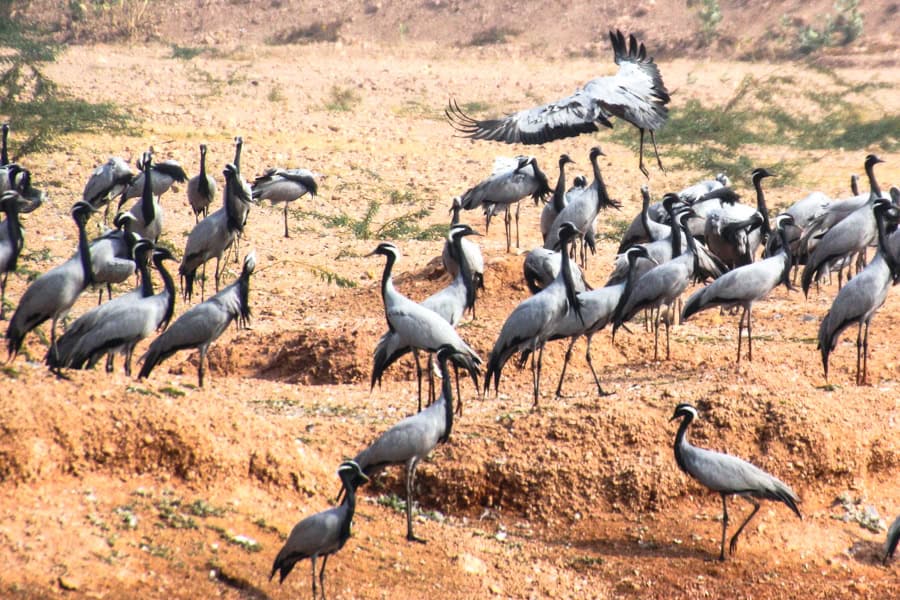
The Story of Khichan Bird Sanctuary
The story of the Khichan Bird Sanctuary began in the 1970s, when a local Jain villager began feeding pigeons and other birds.
Jainism is an ancient Indian religion, one tenet of which is to do no harm, to practice compassion and care for all living things.
The daily feeding began to attract some of the Demoiselle cranes migrating to nearby areas. Those birds spread the word, and more and more cranes began visiting Khichan each year. The villagers welcomed the birds.
Eventually, with crane numbers rising dramatically, the family who fed the birds built an enclosure on the edge of the village to protect them from the threat of dogs and encroaching human settlement.
Today, the Khichan Bird Sanctuary is a focal point of the demoiselle crane migration in the region, and some thirty thousand cranes come here. It’s a designated Key Biodiversity Area and an important site for birdwatching in India.
Each morning in season, visitors can witness the noisy, feathery spectacle of many thousands of Demoiselle cranes – each with a wingspan of between 1.5 and 1.8 metres – descending on the enclosure to feast on hundreds of kilos of grain.
Come March, it’s time for the cranes to leave behind the easy life of their Khichan staycation. Their breeding grounds await across the Himalayas, but their high-altitude migration is a perilous one.
For those that make it back over the mountains to their summer homes in Central Asia and Mongolia, the next couple of months will be tied up with breeding, nesting and telling their friends about the all-inclusive resort they winter at in a small Indian desert village called Khichan.
Back in the car and on the road once more on our tour of Rajasthan, we were left to ponder the curious story of the Jains who fed a handful of birds each day, which led to the surprise creation of a sanctuary for thousands of cranes making one of the world’s toughest annual wildlife migrations.
A cautionary tale about feeding the wildlife? A positive story of human-wildlife interaction? Either way, meeting the cranes of Khichan was, for us, one of the surprise highlights of Rajasthan.
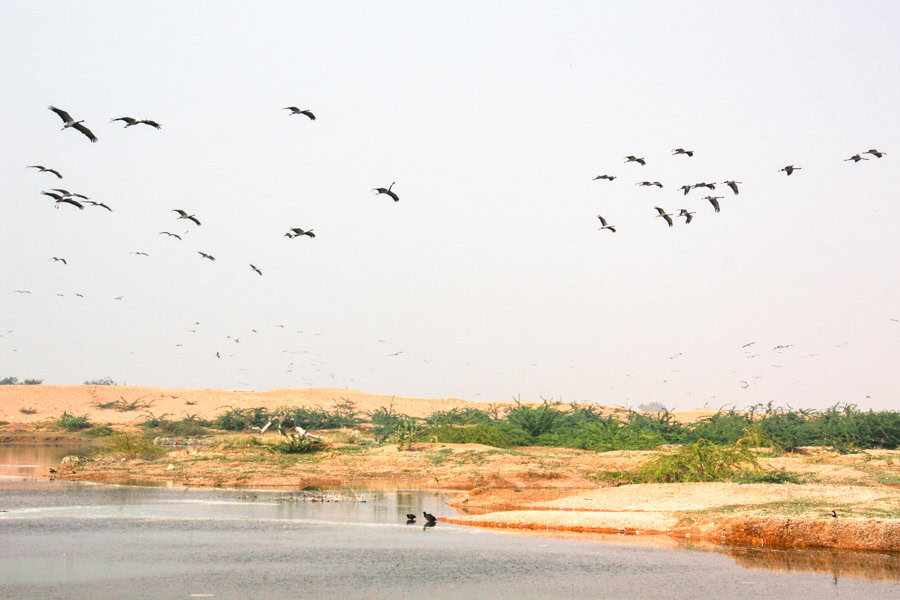
Planning a visit to Khichan Bird Sanctuary
This post contains affiliate links. If you choose to buy through these links we may earn a small commission at no extra cost to you, which helps us to keep Two for the World running. Many thanks for your support!
Getting to Khichan
Khichan village is located in the northern state of Rajasthan in India. The nearest town is Phalodi, which is 6km and 15 minutes by road.
The nearest airport is in Jodhpur, around three hours away. Trains service Phalodi on the Delhi-Jaisalmer train line (which travels via Jodhpur) and the Bikaner-Jaisalmer train line.
If you’re touring Rajasthan by car, Khichan would fit into an itinerary out of Jodhpur,145km to the south-east, or Bikaner, which is around 160km to the north-east and 2.5 hours by toll road.
We visited Khichan en route from Bikaner to Jaisalmer as part of a much longer Rajasthan road trip.
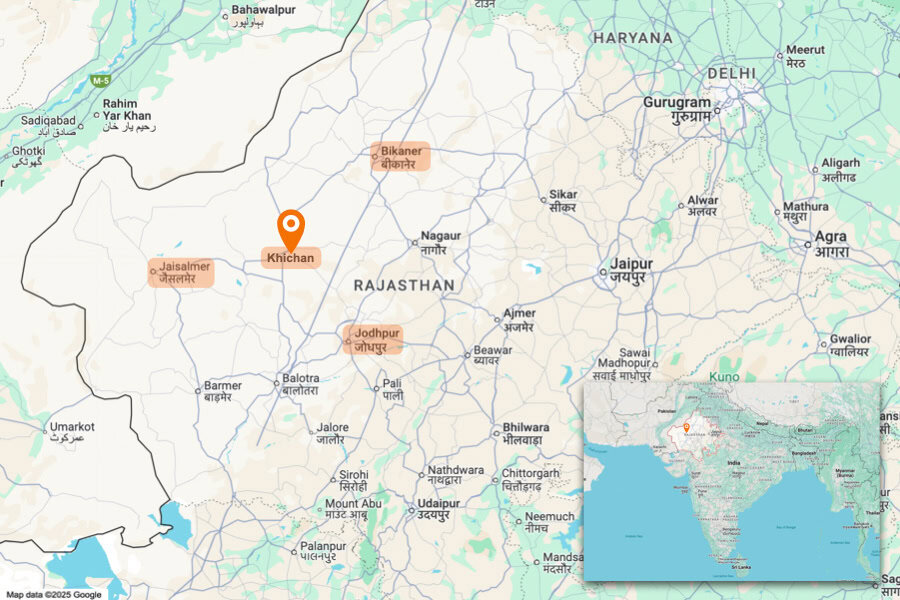
Best time to visit Khichan
Khichan village is in the Thar Desert and it’s very hot for most of the year. Temps are high from March to October, with days averaging over 40 degrees Celsius throughout May and June.
June to September are monsoonal months and while this region doesn’t get nearly as much rain as other parts of Rajasthan, the wettest month is August.
December to February is winter, bringing much more pleasant temps. The demoiselle cranes would appear to agree – this is when they gather in Khichan in the greatest numbers.
When is the best time to see Demoiselle cranes in Khichan?
Demoiselle cranes start arriving in Khichan from late August each year, and stay until around March.
Their numbers peak between December to February, making these the best months to see them.
Where to see Khichan’s Demoiselle Cranes
As we learned when we arrived in Khichan, there are actually a couple of places in the village where the cranes can be seen, depending on the time of day:
The Feeding Centre (Pakshi Chugga Ghar)
This is the fenced-off field where the cranes arrive en masse early each morning to feed on many hundreds of kilos of grain put out for them overnight. Donations from the community and tourists help to fund the mammoth quantities of bird feed. To watch the aerial spectacle unfold, aim to be here by around 7am.
It’s important to note the feeding centre is in a different place to the site marked as the Khichan Bird Sanctuary on Google maps. Search for Pakshi Chugga Ghar; it’s a green square on the map (we’ve also read the site is signposted as Kurja Conservation Reserve).
The Reservoirs
Around 1.2km from the feeding centre, on the other side of the village, are two waterholes. One of these is marked as the Khichan Bird Sanctuary on Google maps.
The cranes retire to these two pools after their morning feed. They spend the rest of the day wading and preening before flying off around sunset to overnight nearby.
This is where we spent time watching the birds. We also spotted a number of other species here, including Eurasian coots, Common sandpipers, Little egrets, a White-throated kingfisher and a juvenile Indian pond-heron.
If you walk through the village to the reservoirs, keep an eye out for the town’s handful of intricately-carved historic townhouses, called havelis.
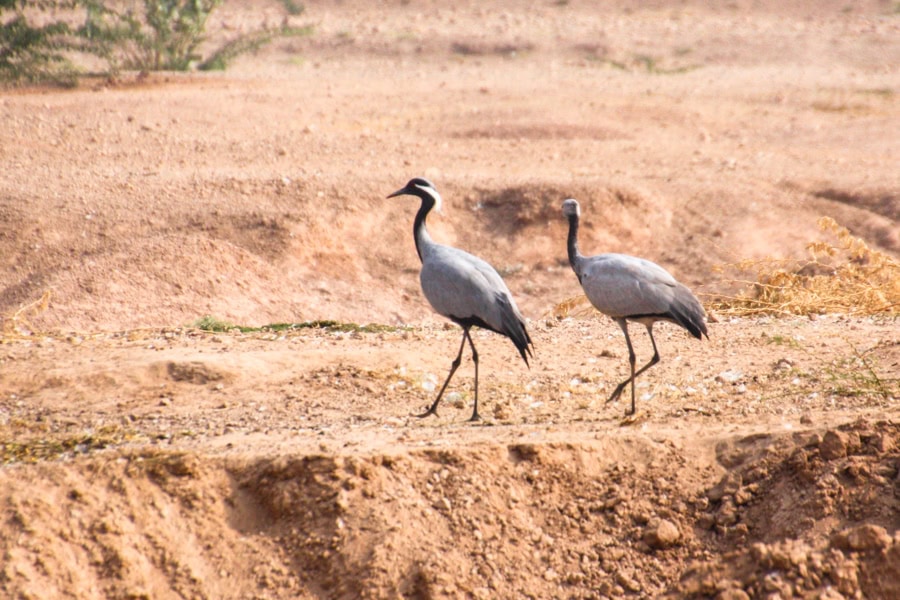
Where to stay
We visited Khichan as a stop-over en route from Bikaner to Jaisalmer, a good way to break up the long journey. Doing it this way, however, means a very early start if you want to arrive in time for the morning feeding. The same goes if you’re coming from Jodhpur or Jaisalmer.
Accommodation near Khichan
If you’d prefer to stay close to Khichan, there are a handful of hotels in and around nearby Phalodi. The following options get consistently good reviews:
- Zone Palace by The Park – Set in a heritage-style building near Phalodi, this hotel has spacious rooms with air-con, private bathrooms and breakfast included, as well as an outdoor pool and on-site restaurant.
- Kurja Resort – Located around 5 minutes’ drive south of Khichan, this resort offers air-conditioned rooms with seating areas, private bathrooms and breakfast included. It also has an on-site restaurant.
Accommodation in Bikaner
Bikaner, around 2.5 hours from Khichan, is an historic city on the edge of the Thar Desert. It’s known for its impressive forts, ornate temples and vibrant markets. Bikaner has a range of accommodation options to suit different travel styles and budgets. The following stays get solid reviews:
- The Prince Haveli (Budget) – Family-run guesthouse in an historic haveli offering clean, comfortable rooms with air-con and city views.
- Hotel Jaswant Bhawan – Clean, spacious rooms with modern amenities, air-con and private bathrooms.
- Cavalry Villa – A friendly homestay with nicely furnished rooms offering garden views, air-con and private bathrooms.
Accommodation in Jodhpur
Jodhpur, known as the Blue City, is around three hours from Khichan. Its vibrant bazaars and striking blue-painted houses, all of it dominated by the mighty hulk of Mehrangarh Fort, make it a popular hub for travellers. Jodhpur also has accommodation to suit all budgets and preferences. The following options get good reviews and all include breakfast:
- Dev Kothi Boutique Heritage Stay – Centrally located in the old city, this family-run guesthouse has spacious rooms with air-con, traditional décor and private balconies, plus a rooftop terrace with views of the fort.
- Khamma Heritage – Heritage-style guesthouse in the heart of Jodhpur offering spacious, air-conditioned rooms with private bathrooms and a rooftop terrace.
- Daspan House (Fancy) – Boutique hotel set in a restored mansion with spacious, light-filled rooms with elegant interiors, powerful showers and garden views, plus a rooftop pool.
Got a question or comment? Drop us a message below!
If you’re looking for more great adventures in India, check out our Rajasthan Road Trip itinerary and our posts on visiting Kerala and the Andaman Islands.

Hello just watched this on BBC2..what a lovely story 23.000 Cranes amazing and so kind for them to feed the birds.
Thanks for your message, Susan, the story of Khichan’s cranes is indeed a lovely one.
Your title captures the essence of two spectacular age old practices – bird migration and Jain philosophy. Both are pure and timeless. Isn’t it marvelous that they should meet in such fascinating circumstances!
Hi Pratima, indeed, this was a very memorable find for us on our travels through Rajasthan! Thanks for your message!
A beautiful and moving story ! Reading about this simple act of love for God’s creatures brought tears to my eyes ! Hats off to the Jain community and all human kind who have this love and appreciation for Nature ! A lesson in peaceful coexistence of all life forms on earth. An example of unconditional love for all of God’s beautiful creatures and creations, for after all, is not Nature (the animals, plants, mountains, rivers … et al) the physical manifestation of God himself ?
Hi KS, many thanks for your lovely message – this is indeed a special story. Best regards!
Great Story.Inspiring.
Thanaks so much, glad you enjoyed it.
What a fascinating story! The transformation of Khichan into a sanctuary for the demoiselle cranes is truly remarkable.
It’s amazing how the local Jain family’s simple act of feeding pigeons unintentionally created a paradise for these magnificent birds.
It’s a perfect example of how human actions, even on a small scale, can have a lasting positive impact on nature. A must-visit for wildlife enthusiasts!
Hi Ovais, thanks for your comment – it is indeed a special place!
I am an 80 yo Japanese American and co-founder of a social justice organization, Tsuru for Solidarity. We are a non-profit organization comprised of Japanese American survivors and descendants who were unjustly incarcerated in American concentration camps during WWII. Inspired by the story of the Demoiselle crane journey across the Himalayas to the Khichan bird sanctuary, I am delighted to find your website and story. It is the one and only thing in my bucket list to see these magnificent beautiful cranes. Like me and my fellow elderly formerly incarcerated Japanese Americans the Demoiselle crane is small yet mighty flock. I’d love to be in Khichan when they arrive. Can you give me directions for how to get to the sanctuary from Jodhpur? Thank you for providing this amazing information. The Japanese refer to these birds as Aneha Cranes.
Hi Satsuki, many thanks for your lovely message. The village of Khichan is around 3 hours and 90 miles’ drive northwest from Jodhpur. We had a car and driver for our trip, and Khichan was a stop en route to the western desert fortress town of Jaisalmer.
If you search for the Khichan Bird Sanctuary on TripAdvisor, you will also find updates and information from other travellers who have visited the village and bird sanctuary recently.
All the best!
Being a jain myself, i am curious to know what is the connection between jains & khichan / crane feeding. And yes you are right, we feed pigeons daily. I have seen my mother feed them since my entire life of 50 years. and i too do this ritual almost everyday.
Hi Rajesh, thanks for your message and interest in this post! The story of the Khichan Crane Sanctuary – as it was told to us – is that it came about directly because of a local Jain family feeding pigeons and their subsequent welcome and care for the demoiselle cranes as they came in larger and larger numbers. It was through their connection with and care for wildlife that the sanctuary exists today. It’s lovely to hear that you too care for local birds! All the best.
Incredible I wish America invested more in our wildlife so many people could benefit from wildlife exploration, there’s a peace you find in God’s creatures untouched by man
Amazing story.
Thanks Cynthia, glad you liked it.